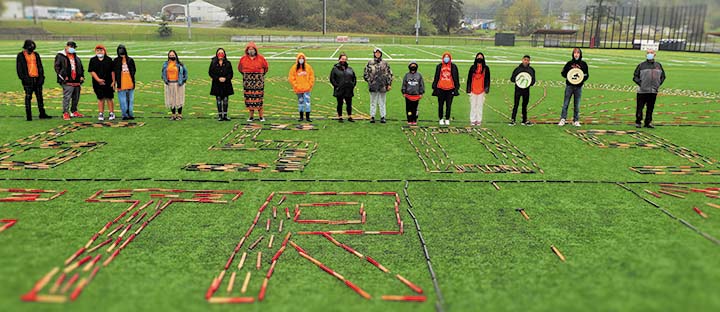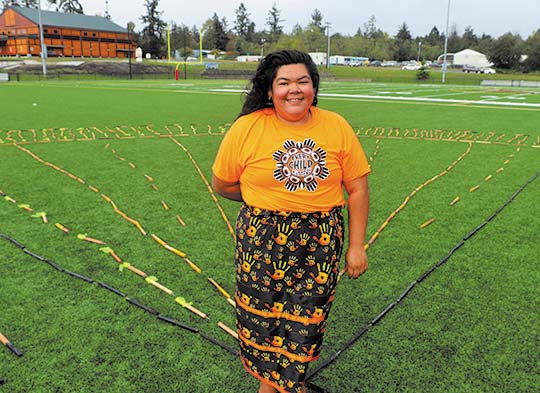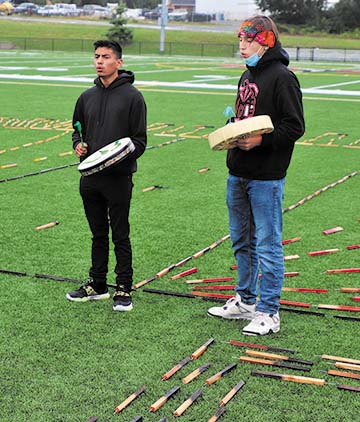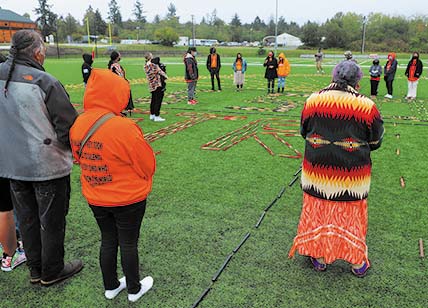By Micheal Rios, Tulalip News

September 30 was Canada’s first-ever National Day for Truth and Reconciliation. A recently created holiday to honor the victims and survivors of our First Nations relatives who experienced forced assimilation at residential schools. Truth and reconciliation have been trending topics for months now, as bodies of Indigenous children being found by the hundreds in unmarked graves at previous residential school sites continues to make global headlines.
It started with the remains of 215 children being discovered on the former grounds of Canada’s largest residential school. That was in May. Since then, thousands of unmarked gravesites have been found at similar sites across Canada. A rising tally of these graves – more than 6,500 so far – has triggered a national reckoning over Canada’s residential school legacy.

Here in the United States, Native Americans know all too well the paralleled legacy of forced assimilation, stolen children, and untold horrors occurring for generations at federally sanctioned, church operated boarding schools.
As historian and Hibulb Cultural Center collaborator Carolyn Marr explained in her Between Two Worlds exhibit, the underlying goal of Indian education from the 1880s through the early twentieth century was to assimilate the Indians into the melting pot of America. The twenty-five, off-reservation boarding schools operating in the United States sought to “bring the Indian to civilization and keep him there,” immersing children in white ways far from the influences of traditional Indian life.
Reservation boarding schools like Tulalip’s, in operation from 1905-1932, aimed to strip Native children of their language, family, ceremonies and culture.
Doing his part to bring attention to National Day for Truth and Reconciliation, while honoring the past, present and future of a thriving Tulalip, elder Harold “Juju” Joseph created a gigantic medicine wheel out of thousands of hand-made prayer sticks. With the assistance of his family, they set individual prayer sticks one by one until they had created the 100ft wide medicine wheel. In the center, the sticks formed the number 6509 in recognition of each Indigenous body uncovered thus far at Canadian residential school sites.
“My goal was to hold a ceremony in our traditional ways, free of any politics, to honor the kids who were taken from their families, their land, their tribes and never made it home,” explained Juju. “What better symbolizes our connection to each other than the medicine wheel? It’s a symbol used by our people all across the United States and Canada to represent the natural cycles of life and are connection to [Mother Earth]. It means as much now as it did before colonization. Within this circle everyone, no matter your age or background, can come together in ceremony and offer prayer.”

An intimate gather of close to 40 Tulalip tribal members and Native relatives within the local school district joined Juju within the circle. Everyone was encouraged to share their thoughts and feelings with the group. Youth culture bearers Image Enick and Tarynn Fryberg shared a song composed by Antone George in honor of those lost at the residential schools.
Following their song offering, Tarynn said, “I drum today for my ancestors who weren’t allowed to drum when they were alive. I encourage all our young ones to pick up the drum because our ancestors couldn’t. Every time we drum, we honor them. They couldn’t practice their traditions, but we can today. Our ancestors are watching us and they are happy to see us in the circle honoring those who never made it back home.”
In Harriette Shelton Dover’s autobiography Tulalip From My Heart, she goes into great detail of her experience at the Tulalip Boarding School. She describes being just nine-years-old and getting whipped for speaking her own language. It was against regulations for any of the students to speak their Native language. She wrote that anytime a child was overheard speaking in their traditional tongue they’d be strapped; a beating with a horse and buggy harness. The school’s matron would strap the girls from the back of their necks all the way to their ankles for daring to speak their own language. It is of little wonder then as to why Lushootseed reached the brink of extinction after multiple generations of Tulalip students were assimilated to English in such a barbaric way.
But 100 years after Harriette and countless others of innocent Indigenous children had their language beaten out of them, proud Lushootseed speaker and educator Natosha Gobin led those within the medicine wheel with a prayer, in their traditional language. Her words washed over those in the circle and brought tears of happiness to some as they reflected on Lushootseed’s revival.

“To speak Lushootseed is to give back voices to our ancestors, the ones who survived and the ones who never made it home,” expressed Natosha. With her fellow language warriors, they’re helping to decolonize the education system by teaching the next generation Lushootseed at TELA, Quil Ceda Elementary, Totem Middle, Heritage and Marysville Pilchuck. “It’s about being able to honor our ancestors by passing on their stories in their language. It’s about empowering our community to honor language, culture and traditions because it all goes hand in hand. Like this medicine wheel we are standing in, we can see how we’re all connected through these sacred teachings. By knowing our teachings and embracing culture and the language we regain the identity that the Boarding School Era attempted to take from our people.”
Language. Ceremony. Culture. These central tenants to Native American identity thrived inside the medicine wheel as the gathering did their best to honor the 6,509. On National Day for Truth and Reconciliation, we know the loss of life claimed by colonization via boarding school assimilation can never be reconciled. The truth is, the best way to honor those who never made it home is to live for them.